 Research Article
Research Article
Technological Reconstruction of Engraved Wall Plaster: The Inscriptions and Graffiti of the Khallat Es- Sirij Reservoir, Israel
Aliza van Zuiden¹, Yonah Maor¹, Elisabetta Boaretto², Joahanna Regev², Dan Shachar1, Nitzan Amitai- Preiss³, Jenny Marcus1, Gilad Itach1 and Yotam Asscher4,1*
*1Artifacts Treatment and Conservation Department, Israel Antiquities Authority, Jerusalem 91004, Israel
2DANGOOR Research Accelerator Mass Spectrometry Laboratory, Weizmann Institute of Science, 7610001 Rehovot, Israel
3Hebrew University of Jerusalem
4Department of Conservation of Material Culture, School of Archaeology and Maritime Cultures, University of Haifa, Haifa 3498838, Israel
Department of Conservation of Material Culture, School of Archaeology and Maritime Cultures, University of Haifa, Haifa 3498838, Israel
Received Date:April 25, 2023; Published Date:December 05, 2023
Abstract
Wall plaster is an excellent medium to encapsulate inscriptions and art graffiti, since the material is consolidated and relatively resistant to erosion, showing both gypsum and lime plasters were used for writing and engraving artistic features in antiquity. The technological reconstruction of wall plasters that were used for art graffiti and inscriptions could help researchers gain an understanding of their chemistry and preparation processes as a reference for conservation and art studies. To understand if the properties of the base material play a significant role, we characterized the chemical and structural properties of wall plasters showing incisions of crosses, people with raised hands, and Arabic names, in the Khallat es-Sirij reservoir near Rosh ha- ‘Ayin, Israel. In this work we show that three different technologies of plaster were used: lime-earth fine grained material, lime-earth course grained material, and lime-crushed ceramics course grained material. The different silicate minerals that were added to the lime influenced the hydraulicity and therefore the hardness of the plasters. The quality of the writings and engravings of features is comparable, indicating that a large variability in plaster technology can be used for inscriptions and art graffiti. This suggests cultural preferences and geographic locations could be the main factor in finding graffiti and inscriptions on wall plasters.
Keywords:wall plaster; water reservoir; Inscriptions and graffiti; lime-technology; hydraulicity
Introduction
Plaster is a relatively thin coating of material on rock surfaces, walls, channels or cisterns, either applied for a functional purpose in preventing loss of water or penetration of incoming water, or as a decorative, descriptive or religious purpose including drawings, paintings or texts. There are several techniques of writing and painting on a plaster surface, but it can be distinguished between models in raised or high relief, or in sunken or deep relief, and incised or pressed into a dry surface, or a wet surface. These variations can be accompanied with the incorporation of pigments, and then when painted on a wet plaster surface it is named a fresco technique, while painted on a dry surface with the aid of an organic binder like egg-white or egg-yellow, gum-arabic or an animal glue, it is named secco technique. The plastered surface can be either gypsum-based or lime-based materials, showing different production pyro-technologies. The gypsum-plaster is prepared by burning the natural sulfate rock to between 100-160°C, while limeplaster is prepared by burning limestone to between 700-800°C [1].
Some combination of text/inscriptions and paintings on wall gypsum-plasters in the southern Levant include the Egyptian royal tombs (ca. 1250 BCE), plastered walls at Kuntillet ‘Arjud in the Sinai-peninsula and Deir Alla in Jordan (ca. 900 BCE). Funeral hieroglyphs texts in royal tombs, with a dazzling multicolored appearance [2, 3], were applied on or in a soft gypsum plaster on a clay-straw rendering. Nickerby [4] writes in his chapter on painting techniques and materials “An extremely sophisticated form of high relief characterizes the plaster in Nefertari’s tomb, and its virtuosity is unsurpassed”. In the Book of Deuteronomy (27:2), the English translation mentions: “when ye shall pass over Jordan that thou shall set thee up great stones and plaster them with plaster and thou shall write on them” [5]. In Hebrew, the word for plaster, which is used here, is ‘Sid’ (lime).
In the eastern part of the Sinai-peninsula, important texts from ca. 900 BCE, which were written in a north-west Semitic script (Phoenician, Aramaic and Hebrew affiliation), were found on the plastered walls in Kuntillet ‘Arjud (‘the solitary hill of the water source’ in Arabic) as well as in Deir Alla (Bal’am son of Be ‘or- KAI- 312) in Jordan, based on crude clay-straw rendering and on top a white local gypsum-based plaster. The texts were written with ink, but without specifying its binder medium [6].
In Israel the samples of writings and texts on a plastered wall surface are more limited, poorly dated and much less exotic, but are still considered an excellent media for historic documentation. Interesting examples are the incisions of written names on the plastered walls of a Roman burial cave (3-4th cent. CE) in Beit Nattif [7] and inscriptions on the wall plaster of Jason’s Tomb in Jerusalem from the late Hellenistic period (110-37 BCE) [8], with two written texts, one in Aramaic and one in Greek. The texts were written with charcoal on a dry, hard and white wall plaster, together with stylistic drawings with charcoal of sailing boats and candelabra, and a deer scratched into the plaster [9]. Unfortunately, most of the charcoal decorations have disappeared due to wrong reconstruction techniques of the monument in modern times.
In the Second Temple period (37 BCE- 70 CE) texts became limited to stone surfaces in burials, showing names on ossuaries and sarcophagus. In this period, plaster was mainly used for decorative purposes only as frescoes and secco’s in the royal palaces and the upper class [10]. In the Byzantine city of Shivta (4-6th CE) a Greek text together with two crosses, was painted with clay or a lime-clay mixture on the plaster of one of the reservoirs [11]. In Jerusalem, in the Wadi Joz area a reservoir from the Fatimid period (10-12th cent CE) was found, with some Islamic texts and private names from an unknown period and were scratched into the dry plaster [9].
The relatively small number of inscriptions and art graffiti which were found in the southern Levant, spanning 2500 - 2000 years between the Egyptian hieroglyphs to Islamic texts in the Fatimid period, demonstrate that plaster is an unexplored medium for writing that was culturally accepted in antiquity. Since texts, images and inscriptions enrich our understanding of ancient societies, it is important to study the properties of the base for writing for archaeological and conservation reasons. Understanding the technological choices and nature of plaster as a material, in the contexts of inscriptions and art graffiti, will help to understand preferences for written information on plastered surfaces. In this work we characterized the chemical and structural properties of plasters with inscriptions of writing and drawings in the late Iron Age Khallat es-Sirij reservoir near Rosh ha- ‘Ayin, Israel, discussing the technological variability of this unrecognized medium for writing.
The Site
A salvage excavation near Rosh ha- ‘Ayin revealed a large-scale water cistern, naming the site “Khallat es-Sirij” (‘water reservoir’ in Arabic) on the lower western side of a moderately sloping hill (115 m asl), 5 km directly southeast of Tel Aphek. A considerable part of the site was uncovered during 2016-2017, and the the findings were described in a few publications [12-14]. Two phases of the late Iron Age (8-7th cent BCE) were identified in the excavation. In the first phase, dated to the later part of the eighth century BCE, a medium-sized structure (18.7 × 17.7 m) was founded on the bedrock. At its center was the main entrance to a large-scale (20 m long) rock-hewn water reservoir. A shaft located about halfway through the reservoir, was installed for extracting the water from aboveground (Fig.1a). In the second phase, most probably dating to the seventh century BCE, the medium-sized structure was incorporated into a large square compound (45 × 45 m) with an open court at its center. This open court was constructed so that the reservoir was located at its southwestern part, while most of the compound was positioned at a higher elevation, above the area that contained the openings through which rainwater fed into the reservoir. The site was probably settled continuously until the abandoned in the Persian (538-332 BCE) or Early Hellenistic Period (332-167 BCE). Some temporary activity was noticed in the Hellenistic, Roman (63 BCE - 326 CE) and Byzantine (4-6th cent. CE) and Mameluke /Ottoman period (13-19th cent CE).
The subterranean reservoir (length 20 m, min. internal height 4 m, min. volume 200 cube/m) was carefully hewn. Eight steps (Figure 1b) led steeply down from the entrance, widening as they descend (max. width 2.5–3.0 m); as the excavation within reservoir was not completed, there are probably additional steps. The reservoir was plastered to its ceiling with a thick light beige-gray plaster of an unusual fine quality. The reservoir was probably first a karstic fissure, in which the inhabitants were able to reach via a vertical shaft, whose opening is located ca. 11 m to the east of the main entrance (Figure 1c). The fissure was subsequently widened into a long and narrow corridor; this form was not accidental, as it was intended to reduce the risk of the reservoir’s roof collapsing (pers. comm. between G. Itach and A. Frumkin).
Along the reservoir plastered walls, one can discern : incisions of six human Figures, most of them with their arms extended upwards while a few hold some kind of an object. In addition, twelve crosses were incised on the plastered walls, and Arabic inscriptions (mainly names). Dating such inscriptions is difficult, but the reservoir contained a few Byzantine potsherds indicate that the site was temporarily inhabited during this period, supported by the crosses incised that are associated with the Byzantine period. The Arabic inscriptions were found mainly on plaster repairs along the walls of the cistern, indicating they were later additions. Four different types of plaster compositions were noticed in the reservoir: the original plaster (Figure 1d), a plaster repair on one of the steps leading into the cistern, a plaster repair with incisions of crosses and people with raised hands (not sampled), and plaster repair patches with Arabic inscriptions.
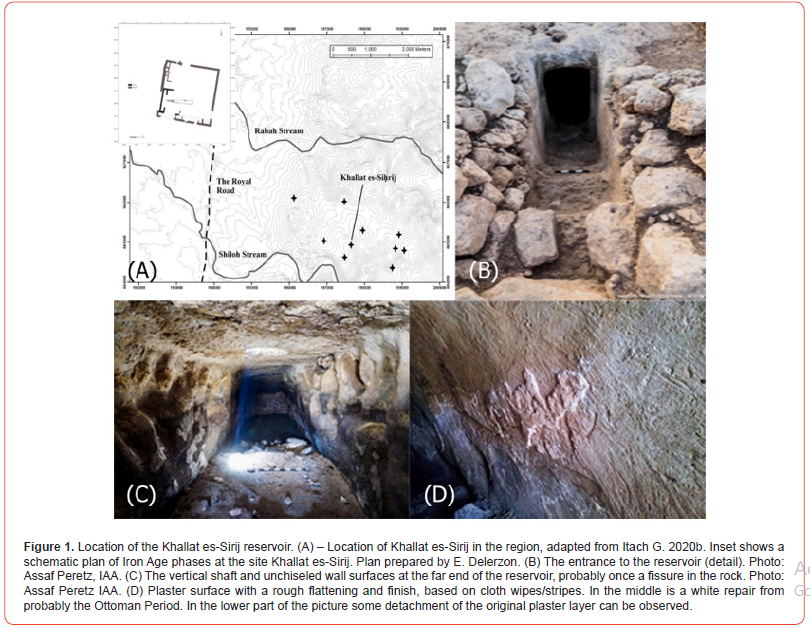
The Khallat es-Sirij reservoir is hewn in the local limestone and/or dolomitic limestone bedrock (see Lithological Map Israel 2014- Geological Institute, and Soil map of Israel 1975- Ministry of Agriculture). The reservoir is situated beneath the present ground level, and all its 6 sides are hewn in bedrock. All sides are plastered, except for the ceiling. Comparable large-scale reservoirs, hewn in bedrock, are also found in Tel Hazor, Megiddo, Tel Gezer, Tel Sheva, Tel Beth Shemesh, Tel Arad and Tel Tsuba [15-16]; most of them are from the Iron Age II period (1000 - 586 BCE), except for the Tel Gezer reservoir, which date is still much discussed. What is rather unique in Khallat es-Sirij, is the fact that the reservoir was hewn in a rural site and not in or next to an ancient city or tell, as others do.
Enormous effort was invested in the Khallat es-Sirij reservoir to prepare a lime binder and to apply ca. 160-200 square meters of a water-tight plaster with a thickness of 0.5-2 cm on the present bed-rock surface. The final plaster surface was not polished or finely flattened. The surface shows signs of coarse flattening performed by a cloth or sponge (Figure 1d). Tsuk shows a picture of the coarsely flattened plaster with brushes and finger stripes in the Iron Age-II Tel Sheva reservoir [11]. In the City of David, in the Beth Shalem excavation, Chalaf/Uziel exposed an eight century BCE wall plaster with finger-stripe-finish as well [17, 18]. The polishing of the plaster surface might have come only into fashion under the influence of the Persian or Greek culture.
The incisions and graffiti
Several incisions were scratched in the original plaster. The incisions of human Figures and crosses on the walls of the Khallat es-Sirij reservoir were most likely engraved during the Byzantine period when the area was undergoing some settlement [19]. Six human Figures (Figure 2a) have been identified in total. Three were incised in the southern wall and three in the northern wall (with a height between 13.5-30.7 cm). One human Figure is incised in profile and appears to hold an object. Twelve incisions of crosses (with a height of 8.5-32.8 cm) have been identified (Figures 2a & 2b). Several of the crosses have forked endings (Figure 2b). (Figure 2)
The incisions of human Figures depict people in a praying posture and are called orans or orants, in which the person is normally standing, with the elbows bent towards the body, the hands raised and outstretched sideways with the palms up [20]. The inscriptions of the human Figures in orans posture represent an early form of Christian art and not necessarily only as a praying posture used by its believers but as a personification of prayer, carrying symbolic meaning of the crucifixion. In this regard, it is possible that the orans represents a stage in late Antique/Byzantine Christian art and symbolism, depicting the crucifixion without the use of the cross, also a transitional stage, since the orans fell out of use in later periods. Only a few examples of orans depictions were discovered in Israel, in Khirbat el-Waziya, western Galilee [21, 22] and the Khallat es-Sirij. Incisions of crosses on plastered walls were found in Horbat Ezra, Har Homa-Jerusalem [23], and Hurbat Burgin [24].
In addition, some incisions were scratched in the later plaster repairs. Six patches of Arabic inscriptions were found near the entrance of the reservoir. Most of the words engraved cannot be understood in their condition today. A few names could be read on three such plaster patches of inscriptions. And the in one place the word ʿamal ‘ the work of ‘ with three names after it. The names are always of males. An engraving of a palm tree is found as part of the row of words of the inscription (Figures 2c & 2e), on the right patch. The Arabic script is not indicative to a specific era. The inscriptions could be dated to the same period, probably to the Late Ottoman period / British Mandate period.
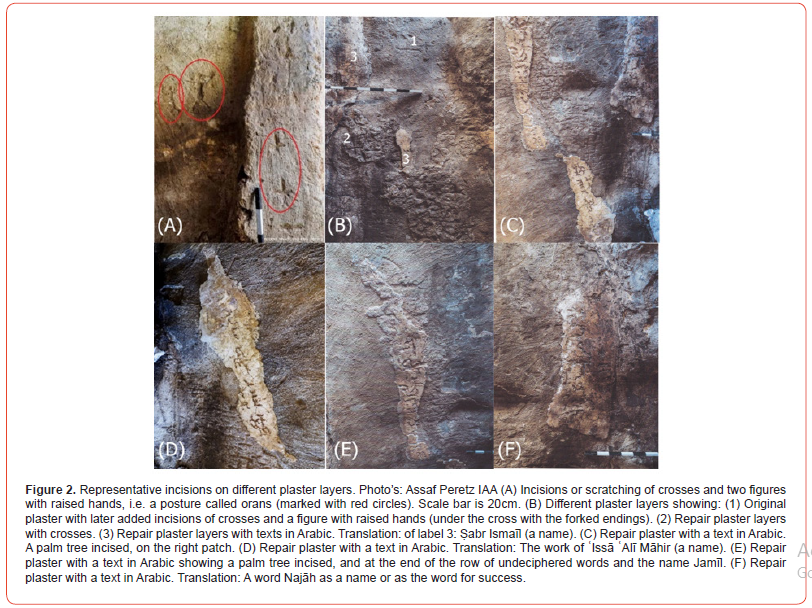
The Arabic inscriptions on all the patches were made by amateurs. It could have been by people who worked in the lime kiln found during the excavation of the site. Since three names are mentioned after the noun ‘work’ it may not be related to the writing on the plaster but could mean working at the site. But the inscriptions could also be written by a passerby to the site of the Khallat es-Sirij.
Methods and Materials:
Analytical methods can give information about the plaster composition, that means its binder and the fillers or aggregates. The following analytical methods were used: the digital microscope, Fourier Transform Infra-Red Spectroscopy (FTIR) for mineralogical identification based on analysis of molecular vibrations in the materials, X-Ray Fluorescence (XRF) for chemical characterization, a stereo microscope for large scale observations, and the Scanning Electron Microscope with Energy Dispersive Spectroscopy (SEMEDS) for chemical composition in high resolution on a microscale.
Sample preparation included a cut at a 90° angle to the plaster surface. The sections of the plaster were polished with the Saphir 250 M1 polishing machine with a gradient of polishing discs with a mesh of 125-75-40-15-micron sized diamonds embedded in the discs and then analyzed via a digital microscope.
Digital Microscopy: Dino-Lite Edge 3.0 was used for visual observations, with a magnification of 13-160x. The grain size was determined using the Dino Capture 2.0 software. Digital microscopy has the advantage of being a quick method to image materials and enables the visual observation of a thick section in order to characterize the types of aggregates and their grain size fraction. A rough estimation of the abundance of the different aggregates, based on visual observations, was used to estimate the relative ratios of the different sizes of aggregates (reported in Table 1).
Table 1:Summary of visual observations under the microscope.
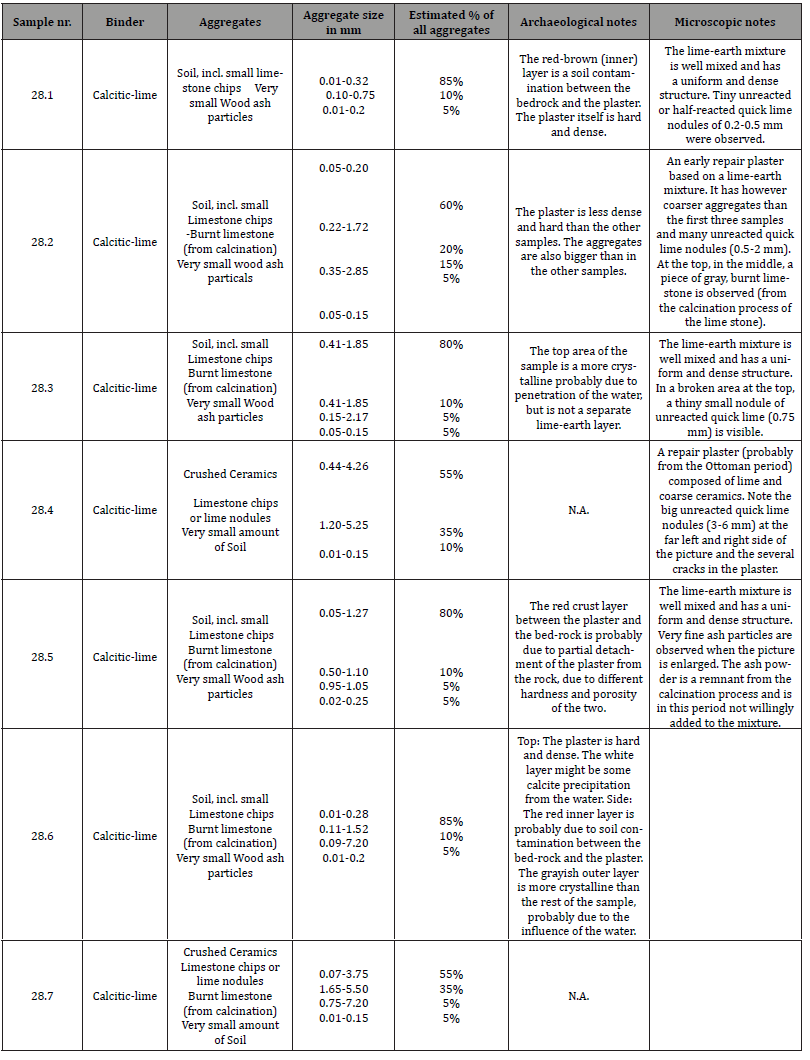
FTIR
Fourier Transform Infrared (FTIR) Spectroscopy (Nicolet iS5 spectrometer) was carried out on all samples and used to characterize the mineralogical composition of the plasters. About 7-10g of sample was crushed with a hammer, ground in an agate mortar and pestle, then sieved through a 500-μm mesh. Then, approximately 0.2 mg was ground to a fine powder and then mixed with KBr (FTIR-grade). Samples were pressed into a 5-mm pellet using a hand press or a 13-mm pellet using a manual hydraulic press at 7 tons (Specac). Infrared spectra were collected at 32 scans per measurement with 4 cm-1 resolution using the software Omnic 7.2.
XRF
X-ray fluorescence (XRF) analysis was carried out on selected samples. About 7-10g of sample was crushed with a hammer, ground in an agate mortar and pestle, then sieved through a 500- μm mesh, and placed in a Bruker sample cup and covered with a layer of Prolene film. XRF analyses were carried out using a Bruker 5i Tracer handheld energy dispersive XRF spectrometer. The instrument is equipped with a Rh-anode, miniaturized X-ray tube operating at a maximum voltage of 50 kV and with a Peltiercooled high-resolution silicon drift detector (SDD). The diameter of the X-ray spot on the sample is about 7–8 mm and accurate positioning on the point to be analyzed is obtained by means of an integrated camera. Chemical quantification was based on Rowe [25], calibration using the Artax (Bruker) software, and calcium (Ca), iron (Fe), magnesium (Mg), silicon (Si) and aluminum (Al) were used to assess the chemical hydraulicity of the plasters as defined by Vola [26].
SEM-EDS
A Phenom XL desktop Scanning Electron Microscope (SEM) coupled with an Energy Dispersive Spectroscopy (EDS) detector was used for elemental analysis of selected plasters (Phenom XL). Analysis was done with the vacuum at medium setting (10 Pa) and the accelerating voltage at 15 keV.
Radiocarbon dating
In order to date the plaster and extract enough material for dating, the plaster was first scraped clean from the surface using scalpel knife. Then it was mechanically broken using a hammer The resulting chunks and powder were searched under binoculars and micro-charred remains were separated using dental tools, soft tweezers and small paint brush. After 20 mg was extracted, the sample was pretreated according to the Acid-Base-Acid (ABA) method described in Boaretto [27]. Following graphitisation, the sample was pressed into an aluminum cathode, and the 14C content was measured at the DANGOOR Research Accelerator Mass Spectrometry Laboratory at the Weizmann Institute of Science [28].
3D Digital Documentation
Portable digital scanning was performed on-site using an Artec Space Spider scanner, with a 3D resolution of 0.1 mm, full color scanning and hybrid geometry.
Results and Discussion
Based on macroscopic observations, different types of plaster compositions were identified in the reservoir (Figure 3): the original plaster (a fine-grained beige-light gray lime-earth plaster [29]; plaster repair on one of the steps leading into the cistern with some coarser aggregates, a plaster repair with incisions of crosses (not sampled), and plaster repair patches with a coarse but polished bright white plaster, containing coarse crushed ceramics. Based on visual observation in high magnification with a digital microscope (Figure 4), one can estimate the type of aggregates, their grain size and the presence of unreacted lime lumps within the plaster [29]. The main aggregate in the original Khallat es-Sirij plaster is local earth/soil, which includes very small limestone particles as well (samples 28.1,28.3,28.5,28.6). It is extremely well mixed and points out a very highly professional approach to plaster preparation. It may contain miniscule lime lumps as well (size is <0.75 mm, only in sample 28.3 detected). The unreacted lime lumps are very typical for the use of quick lime and the “dry slaking” technique [30, 31]. Dry slaking is when a minimum amount of water is added to lime chunks (calcined limestone- CaO), together with aggregates such as clay, sand, limestone chips or river gravel. It causes a very exothermic reaction with heat production up to 400° C, and hence is also known as hot mixing [32]. Sample 28.2 (a later repair) contains bigger lime lumps of 0.5-2 mm, and the Ottoman repairs show the presence of big lime lumps of 2-5 mm. Lime lumps can easily be dissolved in water, and their presence and size might be used as an indicator for a low plaster quality. A summary of the finds based on visual observation in high magnification is presented in Table 1.
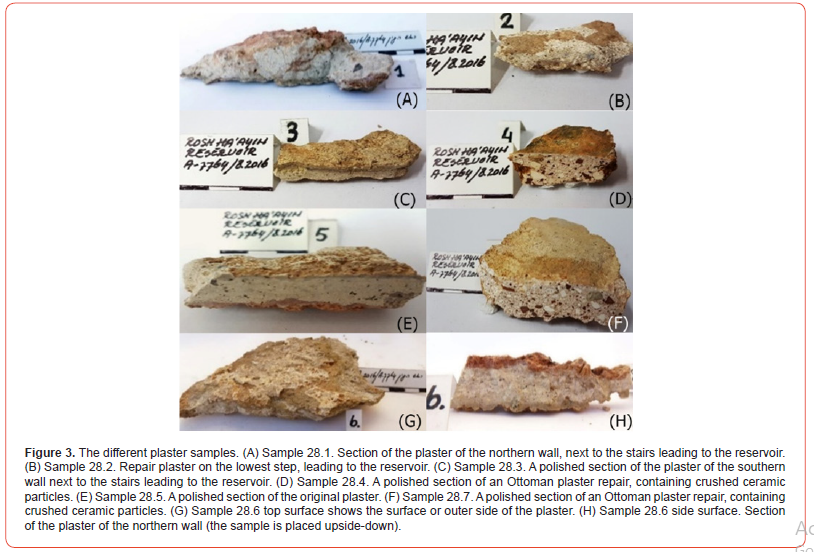
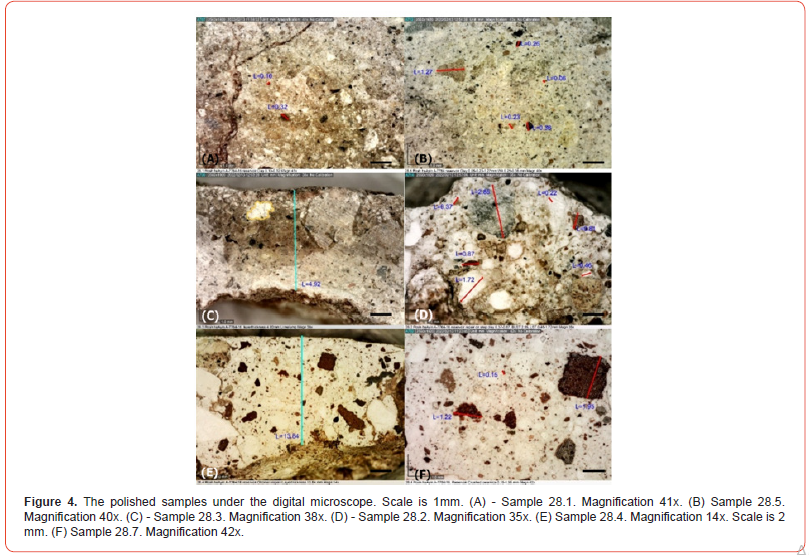
FTIR spectroscopy characterizes the mineralogical composition of the plaster. The characterization of the binder can be done using FTIR since the method differentiates easily between gypsum and lime binders based on the molecular structure of the white material between the aggregates (Figure 5a). Gypsum-based plasters (CaSO4·2H2O) are easily detected based on the sulfate vibrational bands (S-O) with peak positions at 3538, 3400, 1143, 1117, 671 and 602 cm-1. Lime-plaster are mainly calcite (CaCO3) and are easily detected based on the carbonate vibrational bands (C-O) at 1430, 873 and 713 cm-1 [33].
One of the more interesting FTIR measurements for lime-based plasters is the ratio between the carbonates (CaCO3) and silicates (Si- O), based on the ratio between the peak positions 1430 and 1027- 1035 cm-1 respectively. Silicates are minerals that are commonly found in soils, mainly clays (peaks at 1027-1035 cm-1 and 462- 475 cm-1), quartz (peaks at 1084 cm-1, 780-800 cm-1 and 695 cm-1). Minor components in plasters could be phosphates (peaks at 1000-1100 cm-1 and 566, 605 cm-1) and salts like nitrates (1384 cm-1) which are found in water environments [34]. The materials in Khallat es-Sirij clearly show the presence of calcite (Figure 5b), which could be related to both the aggregates and the lime binder, but no gypsum, which rules out the option of the plasters being gypsum-based. In addition, there is a large component of silica in the materials, which could act as a hydraulic component.
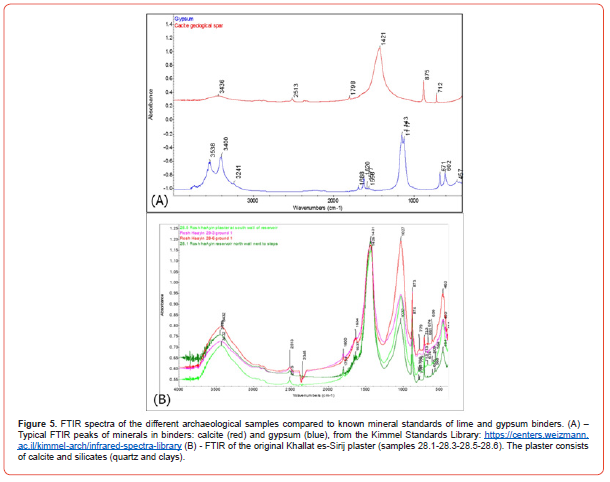
The 28.6 sample has high sillicate peak position (at wave number at 1027), the 28.5 sample a (at 1024), which gives already an indication of their special consistency. The rather low silicate peak of the 28.2 sample and with a small “shoulder” at the left side of the curve, shows that the plaster composition is not the same as the first two samples. One may conclude therefore that the 28.2 sample might be an earlier repair (may be from Persian or Hellenistic period) [29]. The high silicate peaks at 462-475 are typical for the addition of clays. Quartz (SiO2), in the form of siliceous sand (doublet at 797-779 cm-1), is present in 28.6 and 28.3 (Figure 6a). The later repairs with Arabic inscriptions (samples 28.4 and 28.7) show very low Silica peaks but with an unusual silica main peak position (Table 2) of 1028 and 1015 cm-1 (Figure 6b), indicating medium to high magnesium content in the calcitic binder [35].
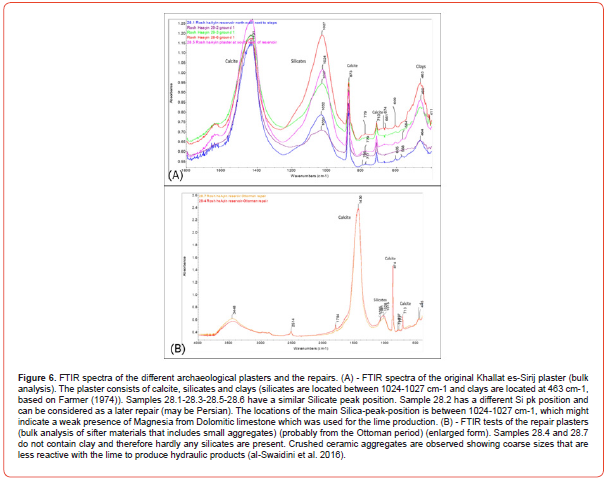
The IR spectroscopy is a useful tool, not only to differentiate between gypsum and lime plasters, or between calcitic lime and magnesia-lime, but also to differentiate between the well burnt/ calcined limestone or under burnt limestone, during the calcination process for obtaining lime. The graph with the grinding curves, calculated via the 3 different calcite peaks (ѵ3, ѵ2 and ѵ4 data) (Table 2) [36-39], will differentiate between geogenic and unburnt or under burnt limestone based on the disordered form of the calcite crystal, which influences the ѵ3, ѵ2 and ѵ4 peak ratios. This is based on the location of the peak ratios relative to spar (black line in Figures 7a & 7b), limestone (brown line) and pyrogenic or wellfired calcite near the plaster curve (green line).
Table 2:Results of the FTIR measurements of calcite with normalized peak height (ѵ2/ ѵ3 and Ѵ4/ ѵ3) of the total matrix (lime binder and aggregates), in order to analyze how far the lime was fired during its calcination process (see also Fig.7a - FTIR grinding curves).

Interestingly, the calcite of the later repair plasters (samples 28.4 and 28.7, marked in red in Figure 7a) is more disordered and less crystalline than the lime of the original plasters (samples 28.1, 28.3, 28.5, 28.6). These later repair plasters also show lower silicates in the matrix, indicating the samples are less hydraulic, supporting previous observations that higher hydraulicity is inversely correlated with the disordered calcitic binder [40]. The data are based on the total powdered matrix (lime and aggregates), therefore, if indeed the results show pyrogenic calcite, we can assume the samples are well preserved, and that the white lumps which are observed under the digital microscope are not limestone, but lime lumps. Lime lumps are badly mixed or unreacted lime, which comes out as clean pyrogenic calcite in the grinding curves, and results show that most subsampled lumps from the repairs are indeed lime lumps (Figure 7b).
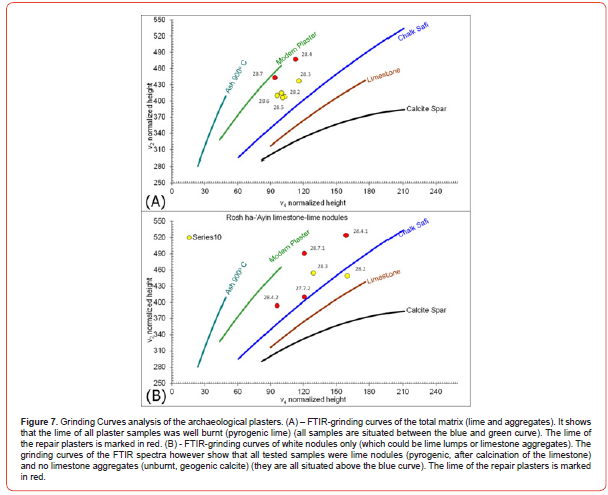
Chemical composition can reveal the nature of additives that were mixed with the lime. Higher silicon (Si), aluminum (Al), and iron (Fe) are associated with higher hydraulicity, and the lime matrix is correlated with higher calcium (Ca) and magnesium (Mg). Minor Elements are phosphorous (P), sulphur (S), potassium (K), zinc (Zn), manganese (Mn) and arsenic (As), associated with the environment. Major chemical elements as detected by XRF on bulk powders, allows estimating the hydraulicity of the plaster following Vola Hydraulic Index formula (Vola et al. 2011) or via the Boyton Cementation Index (Boyton 1966), based on Vicat (1837, 1997) in [30, 41, 42]. The original plasters have a higher hydraulicity than the earlier and later repairs, indicating they are based on different technologies (Table 3).
Hydraulicity, as estimated chemically, depends greatly on the function of the plaster. Wall plaster, for example, can be more porous, softer and of a lesser hydraulic quality than a plaster for reservoirs, cisterns and channels, which needs a harder, denser, non-porous plaster, in order to prevent mechanical and chemical deterioration of the plaster and leakage of the water.
Hydraulic Index [26]:

Table 3:XRF measurements for the wt % of the Elements, the conversion to the wt % of their Oxides and the calculation of the Hydraulic Index.

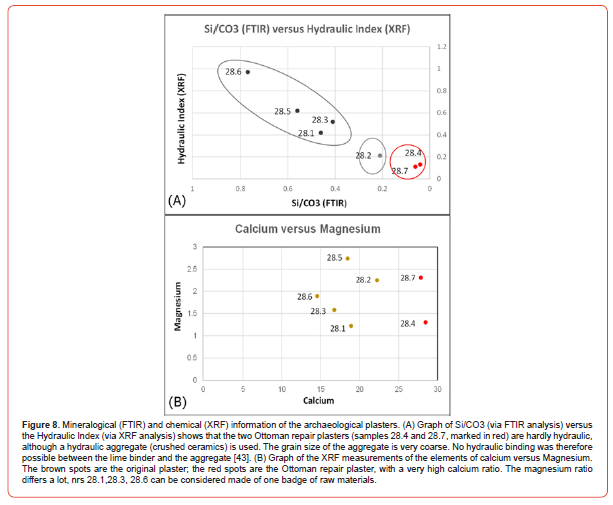
The number of silicates, as estimated by FTIR peak ratios (Si/ CO3) can be compared with the XRF calculations of the Hydraulic Index (HI hereafter) (Fig. 8a), with interesting conclusions. Samples 28.4 and 28.7 (the later repairs) have a very low Si/CO3 ratio, and low HI value, grouping them separately. These samples contained ceramic aggregates (see Figure 4e-f), which are considered hydraulic aggregates. The aggregate size is therefore critical, and indeed these samples have bigger aggregate size as observed in sections (Table 1). Hydraulicity depends greatly on the reaction between the lime and the aggregates, and the finer the aggregates, the more surface area and thus the more hydraulic reaction takes place with the lime [43]. For the FTIR and XRF analysis, the plaster was crushed with a hammer and all the crushed material, including the once coarse aggregates. Sample 28.2 (an earlier repair with rather big aggregates, see Fig. 4d) has also a rather low place in the graph, indicating the aggregates are not based on silica but more on carbonates (Figure 8). All original lime-earth samples are made with a very fine and well sieved soil, with a large surface area and a high Silica content and show therefore high Si/CO3 and HI values. This new method shows hydraulicity as detected by FTIR and XRF can catalog well the different technologies and differentiate between the different repairs and the original plaster.
The amount of Calcium vs Magnesium in the plaster may indicate if dolomite or magnesium-rich limestone were used to prepare the lime. The Magnesium amount differs in all the original plasters (28.1, 28.3, 28.5, 28.6), but is different from later repairs (samples 28.4 and samples 28.7). This supports well the observation that these repairs are based on a different technology.
Chemical composition in the micro-level can show us the hydraulic component in situ in the lime-binder, through SEM-EDS analysis. As the lime-earth mixtures are quite homogenous in the original plaster (Figure 9a) and did not contain any unknown inclusions, a regional test was preferred over point analysis, as it represents an average for the binder’s chemical composition. Sample 28.1 was tested for practical reasons, representing the original plaster. The SEM mapping of calcium and magnesium (Figure 9a) shows both elements overlap in the same region, indicating both constitute the binder. Although magnesium is evenly distributed, as is calcium, its quantity is much less (Figure 9b).
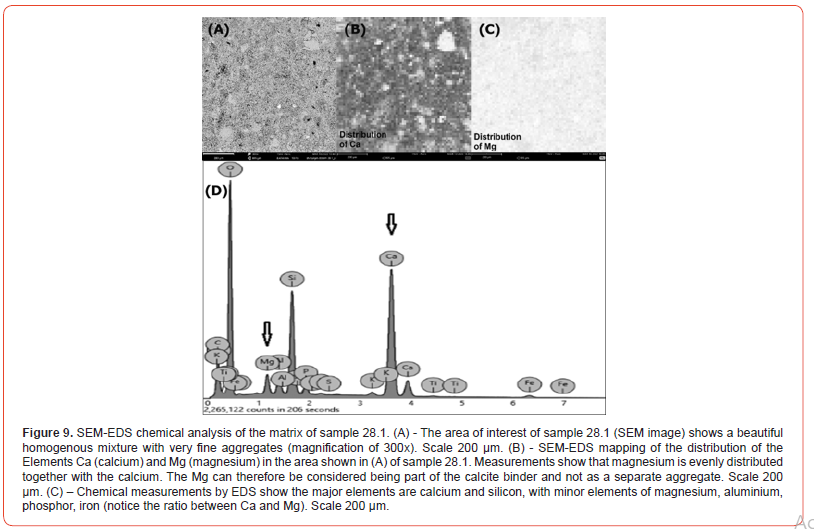
Only one sample for Radiocarbon dating was measured due to the difficulty of obtaining organic material for sufficient sample size [49,50,51,53]. The sample is associated with the original plaster (location of sample in Figure 10a), and it is associated with the Persian period, between, 539-416 BCE in 1σ range confidence. The 2σ range is between 745-405 BCE (Table 4), associated with the end of the Iron Age through the Persian period. It must be noted that since the sample consists of multiple pieces of charred material including short-lived material and charcoal that could have inbuilt “old-wood effect”, the real age could be younger. Based on stratigraphy and the dating of pottery and other small finds, the excavators suggested that the reservoir was hewn during the late eighth – early seventh century BCE [13,52] and possible gap between the excavator’s date and the C14 dating will be discussed in more details elsewhere. (Figure 10).
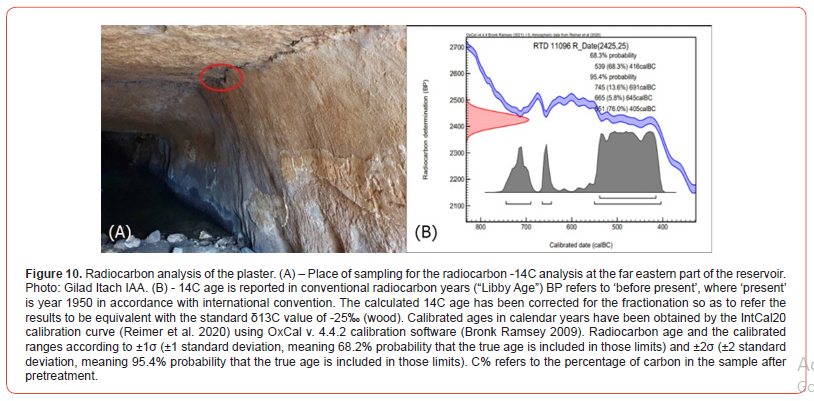
Table 4:Radiocarbon dating data for the charred remains from the plaster in locus 990. The table includes: lab number “lab#, Sample Field ID (Including locus and basket number), (C%) after pretreatment, the uncalibrated date (C-14 age ± 1-year BP), calibrated ranges for the ± 1 and ± 2, stable carbon isotopes ratio d13C.

Discussion
Plaster technology reflects the choices of ancient societies in the adaptation to the local resources to functional and decorative needs, between the different binders (mainly gypsum and lime), and a variety of local (and rarely imported) aggregates or fillers. Binders can be identified by their chemical and mineralogical signatures, depending on the source material, differentiating between limestone (only Ca), dolomite (Ca and Mg), magnesia (only Mg), gypsum (Ca and S) and marl (or any other natural hydraulic binder, showing Ca and Si). The plaster binders of the Khallat es- Sirij reservoir show lime is the major component, therefore, limestone was the source material for making the lime-plaster. One option is that the quick lime (the product of calcined limestone) was “dry slaked” and mixed directly with wet soil or wet sand [30, 31]. Another option is that the quicklime was “wet slaked” in slaking pits filled with water, with aggregates added only after half a year or more, according to the technical descriptions of Vitruvius [44]. “Dry slaking” was probably the accepted technology from the dawn of history up till probably the Early Roman period (later periods are not yet checked by the authors). The presence of unreacted small or bigger lime lumps or overburnt or under burnt limestone (identified in Khallat es- Sirij via the Digital Microscopy) is typical for the use of “dry slaked” quick lime. Another evidence for dry slaking is the atomic disorder of the calcite, as measured in FTIR, showing the lime lumps are highly disordered and pyrogenic, and therefore, are not limestone aggregates (Figure 7b).
The lime was probably made of a weak dolomitic rock based on the presence of magnesium in the samples, based on the equal distribution of the magnesium in the matrix as shown in the SEMEDS (calcitic limestone with different amounts of Magnesia) [45-47], which might be partly responsible for the excellent hard quality. The aggregate or filler of the original plasters is fine-grained soil/clay, which is presumably the source for the silicates that were found in the matrix, with sporadically some small burnt/calcined limestone particles (remnants of the lime burning process). The low presence of quartz, as indicated in the FTIR, might indicate clay-rich soil or that it was treated to remove the sand. No volcanic materials were present based on the chemical composition and visual observations, limiting the sources of silicates to soil in the early plasters and crushed ceramics for the later repairs [48]. Lime/earth plasters are a typical composition for Iron Age II and Persian plasters in the mountainous areas of Israel [29], which is supporting the single radiocarbon date of the original plaster that ranges between 744- 404 BC (end of the Iron Age through the Persian period). The very fine grain size of the aggregates as seen in the digital microscope is supported by hydraulicity estimations made by the XRF (large HI index) and the FTIR (large Si/CO3 values). The finer the grain size of the aggregates, the better hydraulic reaction takes place [43], and the better the final quality and hardness of the plaster.
Most lime-earth plasters from the Iron Age II period in the Jerusalem area [29] are made out of two or more thin layers with the same composition, in order to prevent shrinkage (due to the fine aggregate size of the clays). The Khallat es-Sirij samples show however one thick plaster layer with one plaster composition, without internal shrinkage lines or cracks, indicating a unique technological choice with exceptional quality. Analytical methods such as compressive strength can be useful to try to understand the outstanding quality of this wall plaster and why the one thick layer did not show any sign of shrinkage and cracking. However, compressive strength tests, which are mainly used for studying modern concrete for defining strength and hardness, require test blocks of 10:10:10 cm. Such thickness is never acquired with ancient plasters, therefore quality in this work is mainly based on visual observations and analytical methods for characterizing the chemical and structural properties of the materials. The only drawback of such an exceptional hard and dense plaster is the possibility of detachment from the rock itself, especially if the rock is less dense than the plaster. Sporadically some complete detachment of the plaster from the bedrock was observed (Figure 1d).
A perfect chemical and mineralogical composition of a plaster, however, does not always go parallel with the final quality of ancient plasters. Quality depends on many factors, like the type of lime, its burning temperature, the type and duration of the “dry slaking”, the time that elapsed between lime production and plaster preparation/application, the weather conditions, the type of aggregates, the size of the aggregates, the wetting and moment of wetting of the fresh applied plaster etc., [52]. This can be observed in the variety of repairs to the original plaster wall. Several repairs show that different aggregates were used, mainly courser limestone lumps to fix the steps, and crushed ceramics to fix other wall plaster locations. All these technological variabilities change the quality of the plaster.
The incisions on the original, unpolished plaster, which were much later applied, probably in the Byzantine period (people with raised hands, crosses), could only be scratched on this dry and hard surface. The presence of the people with raised hands, in orans posture, is a well-known and important art-historical phenomenon and represent an early form of Christian art and also a transitional stage, since the orans fell out of use in later periods [22, 20]. Crosses, present in the plaster repairs, are found more regularly, and are chiseled or pressed in half dry plaster and/or scratched in dry plaster. The Arabic texts are scratched in a polished and dry plaster repair and can be classified as pure graffiti. Interestingly, all the different incisions, made presumably at different periods based on their content (crosses, Arabic text), were all applied in the different plaster types. The depth of the incisions and the clean cuts of them in the plaster would tell us on the tools used, and quality of plaster. Unfortunately, the portable 3D scanner that provides a virtual representation of the wall and enables research on the depth of the incision and the tool used, were not allowing such analysis due to the resolution of the measurement (Figure 11).

Future developments in 3D scanning will allow such research to provide insight on the correlation between plaster quality and writing on walls. Until then, it can be noted that at different periods, different plaster types were used for incisions to provide historical sources on plastered walls, making the choices of past societies to use plaster as a medium for writing text and graffiti a more cultural one.
Conclusion
In Khallat es-Sirij Reservoir, several plaster technologies were found, showing that lime-earth, lime-crushed limestones and limecrushed ceramics were used to plaster the walls of the reservoir. Writing and art graffiti that are associated to a time span of more than 2000 years show that incisions were applied on all the different plaster types, and most likely after the plaster was dry. This may reflect a local tradition of using plaster as a medium for writing [55]. The original plaster and its the repairs show a quality which was sufficient for incisions or scratching with a sharp tool. As the tradition of Writing and art graffiti on plasters is not dominant in the southern Levant, the findings in Khallat es-Sirij reservoir are unique [56].
Acknowledgments
The Radiocarbon research was supported by the Exilarch Foundation for the Dangoor Research Accelerator Mass Spectrometer (D-REAMS) Laboratory.
We wish to thank the Kimmel Center for Archaeological Science and George Schwartzman Fund for the laboratory and funding support for the material analysis.
Conflict of Interest
No conflict of interest.
References
- Artioli G (2010) Scientific methods and cultural heritage: an introduction to the application of materials science to archaeometry and conservation science. OUP Oxford pp. 242-250.
- Angel Corzo M, Afshar M (Eds.), (1993) Art and Eternity, The Nefertari wall paintings project 1986-1992. The J. Paul Getty Trust.
- Revue Biblique T, McDonald JK (1996) House of Eternity: The Tomb of Nefertari. Publ. The Getty Conservation Institute and J. Paul Getty Museum 125-3: 406-435.
- Nickerby S (1993) Original Painting Techniques and Materials Used in the Tomb of Nefertari. In: Angel Corzo M., Afshar M. (Eds.). The Nefertari wall paintings project 1986-1992, The J. Paul Getty Trust.
- Harkavy A (1966) The Pentateuch (with English translation), Hebrew Publishing Co. New York, pp. 333.
- Wearne GJ (2015) The plaster texts from Kuntillet Ajrud and Deir Alla, an inductive approach to the emerge of northwest semitic literary texts in the first millennium B.C.E. Thesis. Department of Ancient History Macquarie University.
- Zissu B, Klein E (2011) A Rock-Cut Burial Cave from the Roman Period at Beit Nattif, Judean Foothills. Israel Exploration Journal 61(2): 196-216.
- Rahamani J (1964) Jason’s Tomb. Atiqot 3: 1-12
- Vilnay Z (1993) Jerusalem-Encyclopedia. Achi-ever and Zamura Bitan Publ 440: 988-989.
- Reich R (2021) Day by day- Everyday life of the Jewish Community in the late Second Temple Period. Pardes Publishing/ Haifa University Publishing (in Hebrew), pp. 169-222.
- Tsuk Ts (2011) Water at the end of the tunnel, Yad Ben Zwi publication 374: 76.
- Brandl B, Itach G (2019) A Locally made Scaraboid from Khallat es-Sihrij Near Tel Aphek and Its Neo-Assyrian Connection. In: Journal of the Institute of Archaeology of Tel Aviv University 46(2).
- Itach G (2020a) Rosh Ha- ‘Ayin, Khallat es-Sihrij- Preliminary report Hadashot Archaeologiot Vol 132.
- Itach G (2020b) A response to N. Na’aman: A recently unearthed Assyrian Road Station (Bit Marditi) near Tel Aphek. In: Rivista di storia, ambienti e culture del Vicino Oriente Antico Vol 17.
- Gibson S (2009) The Suba water system as a clay-production plant in the Iron Age II. In: Eretz Israel Archaeological, Historical and Geographic Studies, (Publ. Israel Exploration Society), pp. 45-56.
- Tsuk T (2018) Innovations in the Study of Ancient Water Systems In: Qadmoniot, A Journal for the Antiquities of Eretz-Israel and Bible Lands, Published by: Israel Exploration Society 155: 3-17.
- Chalaf O, Uziel J (2018) Beyond the Walls: New Findings on the Eastern Slope of the City of David and their Significance for Understanding the Urban Development of Late Iron Age Jerusalem. In: Meiron E. (Eds.) -City of David – Studies of Ancient Jerusalem, Megalim and Israel Nature and Parks Authority, pp. 17-32.
- Shalom N, Shalev Y, Uziel J, Chalav O, Lipschits O, et al., (2019) How is a city destroyed? (in Hebrew) New Archaeological Data of the Babylonian Campaign to Jerusalem.
- Shadman A (2019) Rosh Ha- ‘Ayin (South and East) - Hadashot Arkheologiyot: Excavations and Surveys in Israel 131.
- Finney PC (1997) Orans. In: E. Ferguson ed. Encyclopedia of Early Christianity 2 (2nd edn), New York–London, pp. 381-382.
- Klein E, Distelfeld N (2014) Khirbat el-Waziya. Hadashot Arkheologiyot: Excavations and Surveys in Israel 126.
- Klein E, Zissu B, Distelfeld N (2018) Byzantine Graffiti in Underground Water Facilities in the Galilee and Judean Foothills.
- Sulimani G (2012) Har Homa. Hadashot Arkheologiyot: Excavations and Surveys in Israel 124.
- Zissu B, Ganor A, Klein E, Klein A (2013) New Discoveries at Horvat Burgin in the Judean Shephelah: Tombs, Hiding Complexes, and Graffiti. Palestine Exploration Quarterly 145(1): 29-52.
- Rowe H, Hughes N, Robinson K (2012) The quantification and application of handheld energy-dispersive x-ray fluorescence (ED-XRF) in mud-rock chemo stratigraphy and geochemistry. In: Chemical Geology 24(324-325): 122-131.
- Vola G, Gotti E, Brandon C, Oleson JP, Hohlfelder RL (2011) Chemical, mineralogical and petrographic characterization of Roman ancient Hydraulic concretes cores from Santa Liberata, Italy, and Caesarea Palestinae, Israel. In: Periodico di Mineralogia 80(2): 317-338.
- Boaretto E (2009) Dating Materials in Good Archaeological Contexts: The Next Challenge for Radiocarbon Analysis. Radiocarbon 51(1): 275-281
- Regev L (2017) D-REAMS: A new compact AMS system for radiocarbon measurements at the Weizmann Institute of Science, Rehovot, Israel. Radiocarbon 59(3): 775-784.
- Van Zuiden A, Asscher Y (2021) Lime-based Plasters from Iron Age II till the Roman Period in Jerusalem and its region: Aggregate identification and proposal for a typological classification. In: Peleg-Barkat (Eds.) - New Studies in Archaeology of Jerusalem and its Region, collected papers for the 2021 conference. Tel Aviv University, Israel Antiquities Authority and The Hebrew University of Jerusalem, pp. 225-251.
- Van Balen K, Van Bommel B, Van Hees R, Van Hunen M, Van Rhijn J, et al., (2003) Lime book. Ancient Monuments Department (today: Cultural Heritage Agency). Zeist, Holland 2003 (in Dutch).
- Copsey N (2021) Hot Mixed Lime and Traditional Mortars. The Crowood Press.
- Karkanas P (2007) Identification of lime plaster in prehistory using petrographic methods: a review and reconsideration of the data on the basis of experimental and case studies. Geoarchaeology: An international journal 22(7): 775-796.
- Farmer VC (1974) The Infrared Spectra of Minerals. Mineralogical society monograph 4: 331-363.
- Weiner St (2010) Micro archaeology, beyond the visible archaeological record. Cambridge University Press.
- Secco M, Asscher Y, Ricci G, Tamburini S, Preto N, et al., (2022) Cementation processes of Roman pozzolanic binders from Caesarea Maritima (Israel). Construction and Building Materials 355: 129128.
- Chu V, Regev L, Weiner St, Boaretto E (2008) Differentiating between anthropogenic calcite in plaster, ash and natural calcite using infrared spectroscopy: implications in archaeology. Journal of Archaeological Science 35: 905-911.
- Regev L, Poduska M, Addadi L, Weiner S, Boaretto E (2010) Distinguishing between calcites formed by different mechanisms using infrared spectrometry: archaeological applications. Journal of Archaeological Science 37(12): 3022-3029.
- Toffolo MB, Regev L, Dubernet St, Lefrais Y, Boaretto E (2019) FTIR-Based Crystallinity Assessment of Aragonite-Calcite Mixtures in Archaeological Lime Binders Altered by Diagenesis. Minerals 9(2): 121.
- Toffolo MB, Regev L, Mintz E, Kaplan-Ashiri I, Berna F, et al., (2020) Structural Characterization and Thermal Decomposition of Lime Binders Allow Accurate Radiocarbon Age Determinations of Aerial Lime Plaster. Radiocarbon 62(3): 633-655.
- Asscher Y, van Zuiden A, Elimelech C, Gendelman P, Sharvit J, et al., (2020) Prescreening Hydraulic Lime-Binders for Disordered Calcite in Caesarea Maritima: Characterizing the Chemical Environment Using FTIR. Radiocarbon 62(3): 527-543.
- Elsen J, Brutsaert A, Deckers M, Brulet R (2004) Microscopical study of ancient mortars from Tournai (Belgium). Material Characterization 53: 289-294.
- Elsen J, van Balen K, Mertens G (2012) Hydraulicity in historic lime mortars: a review. In: Rilem Bookseries, pp. 121-136.
- Al-Swaidini AM, Aliyan SD, Adarnaly N (2016) Mechanical strength development of mortars containing volcanic scoria-based binders with different fineness - Engineering Science and Technology, an International Journal 19: 970-979.
- Vitruvius (Vitruvio 1997) De Architectura, edited by P. Gros, translation and commentary by A. Corso and E. Romano, Edizioni Einaudi, Turin, 2.
- Artioli G, Secco M, Addis A (2019) The Vitruvian legacy: Mortars and binders before and after the Roman world. EMU Notes in Mineralogy 20: 151-202.
- Chever L, Pavia S, Howard R (2010) Physical properties of magnesian lime mortars. Materials and Structures 43, (Rilem 2009), pp. 283-296.
- Pavia S, Fitzgerald B, Howard R (2005) Evaluation of properties of magnesian lime mortar. In: Brebbia C.A. and Torpiano A. (Eds.). Structural Studies, Repair and Maintenance of Heritage Architecture IX. Malta, June 2005. Vol 83 WIT Transactions on The Built Environment. WIT Press, pp. 375-384.
- Bishop JL, Lane MD, Darby Dyar M, King SJ, Brown AJ, et al., (2014) Spectral properties of Ca-sulfates: Gypsum, Bassanite and Anhydrite. In: American Mineralogist 99: 2105-2115.
- Bronk Ramsey C (1995) Radiocarbon Calibration and Analysis of Stratigraphy: The OxCal Program. Radiocarbon 37(2): 425-430.
- Bronk Ramsey C (2001) Development of the Radiocarbon Program OxCal. Radiocarbon 43(2A): 355-363.
- Bronk Ramsey C (2010).
- Itach G, Forthcoming the Assyrian Interests in the Western Part of the Province of Samaria - a case study from Khallat es-Sihrij and its vicinity. In Koch I (Eds.). To and from the Levant: Mass Deportations during the Age of the Empires. Hebrew Bible and Ancient Israel.
- Reimer P (2020) The IntCal20 Northern Hemisphere Radiocarbon Age Calibration Curve (0-55 cal kBP). Radiocarbon, 62(4): 725-757.
- In: Peleg-Barkat et al. (Eds.) (2019) New studies in Archaeology of Jerusalem and its Region, collected papers of the 2019 conference, Tel Aviv University, Israel Antiquities Authority and The Hebrew University of Jerusalem, pp. 229.
- Stuiver M, HA Polach (1977) Discussing reporting C-14 data." Radiocarbon 19(3): 355-363.
- Yizhaq M, G Mintz (2005) Quality controlled radiocarbon dating of bones and charcoal from the early Pre-Pottery Neolithic B (PPNB) of Motza (Israel). Radiocarbon 47: 193-206.
-
Aliza van Zuiden, Yonah Maor, Elisabetta Boaretto, Joahanna Regev, Dan Shachar, Nitzan Amitai-Preiss, Jenny Marcus, Gilad Itach and Yotam Asscher*. Technological Reconstruction of Engraved Wall Plaster: The Inscriptions and Graffiti of the Khallat Es-Sirij Reservoir, Israel. Open Access J Arch & Anthropol. 5(2): 2023. OAJAA.MS.ID.000607.
-
Demokritos, Archaeometry, lyophilizer, Radiocarbon, Carbohydrates, Neolithic
-

This work is licensed under a Creative Commons Attribution-NonCommercial 4.0 International License.






